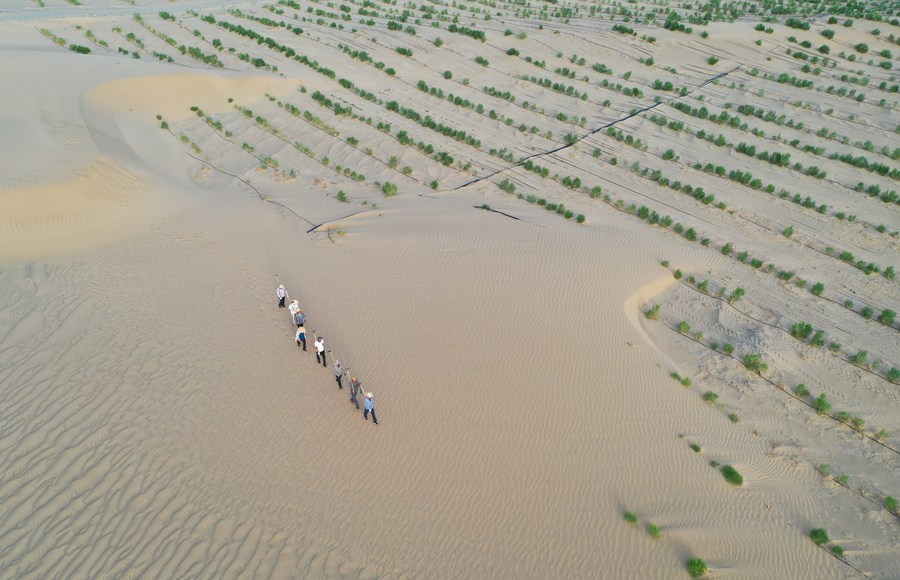China's sustained afforestation efforts green the world

This aerial photo taken on July 5, 2022 shows people checking the condition of Haloxylon plants in Qiemo, a desert county in northwest China's Xinjiang Uygur Autonomous Region. (Xinhua/Li Xiang)
BEIJING, April 6 (Xinhua) -- Spring is the season for new life. In China, the peak time for spring plowing and sowing is around the Qingming Festival, which falls on Wednesday this year, when people from all walks of life go out and plant trees to make the land greener.
From top leaders to ordinary citizens, planting trees has been a prevalent practice for the Chinese, who voluntarily take part in the country's massive greening efforts every year to clearly show just how much the world's second-largest economy values greenness and ecological conservation.
China designated March 12 as National Tree Planting Day in 1979 and launched a nationwide voluntary tree-planting campaign in 1981. From 1982 to 2021, Chinese citizens voluntarily planted approximately 78.1 billion trees across the vast country.
Citizens are also encouraged to adopt or nurture trees, donate money, and conduct volunteer work related to trees.
The country's internet-based greening campaign "Ant Forest," allows people to adopt trees by paying due contributions online or by garnering enough credits by performing low-carbon activities like taking public transportation, in exchange for a real tree to be nurtured in their names.
By the end of May last year, more than 550 million people had participated in the project to plant over 200 million trees, reducing exhaust equivalent to 12 million tonnes of carbon dioxide.
After decades of afforestation, China has created the world's largest planted forests, with its forest coverage rate more than doubling from 12 percent in the early 1980s to 24.02 percent last year.
The country's afforestation area reached 960 million mu (64 million hectares) over the past decade. In 2022 alone, the Chinese people planted a total of 3.83 million hectares of new forests, official data showed.
As a result of sustained forest conservation and tree planting efforts, a 2019 finding published in Nature Sustainability showed that at least 25 percent of the foliage expansion since the early 2000s globally came from China, based on data from NASA satellites.
Thick forests have also become a substantial source of revenue for locals. Last year, the output value of China's forestry and grassland industry reached 8.37 trillion yuan (about 1.22 trillion U.S. dollars), while the foreign trade volume of forest products was 191 billion dollars.
"Green development with both ecological and economic benefits is a highlight and distinctive feature of Chinese modernization," said Qu Jianjun, a researcher with the Northwest Institute of Eco-Environment and Resources under the Chinese Academy of Sciences.
China has moved to facilitate its afforestation efforts with legislative improvements. The country's law on forest protection was revised in 2019 and went into effect in 2020, in a bid to better protect the country's forests and facilitate green development.
Behind China's remarkable green achievements are advances in afforestation and sand control technologies. In Minqin, a county in the middle of two deserts in the northwestern province of Gansu, methods like drip irrigation and sand barriers have helped increase local forest coverage from 11.52 percent in 2010 to 18.28 percent currently.
"China has become a world leader in sand control technologies," said Liu Hujun, director of the International Cooperation Center of Gansu Desert Control Research Institute. Since the 1990s, Liu's institute has helped train nearly a thousand technicians and government officials from 87 countries.
Yang Zhusong, an associate professor at Tsinghua University, said China's sustained afforestation efforts have contributed to addressing global climate change and promoting green and low-carbon development, thus creating greater development dividends for the world.
"The scientific and effective prevention and control methods of the Chinese government have greatly changed the county, and made me see the hope of improving the ecology in my hometown," said Rezaali Pakzad, an Iranian PhD student who carried out field surveys and research in Minqin for soil desertification control studies.
Under a long-term plan, China expects to increase its forest coverage rate to 26 percent by 2035. By then, China's forest stock will rise to 21 billion cubic meters, and the area of natural forests will be kept at about 200 million hectares.


